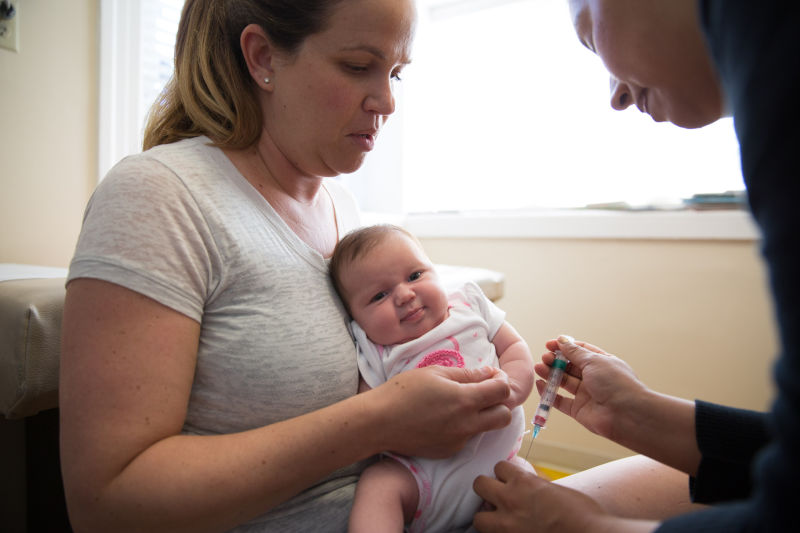KQED downloaded the data and calculated a PBE rate and an MMR rate for nine Bay Area counties and a statewide average. We contacted CDPH to request an interview about our analysis.
But late Monday, after calls from reporters, CDPH deleted the data set from its site, saying it was preliminary and incomplete, and said final data would be published by mid-January.
According to the KQED analysis, across the Bay Area, most counties saw a decline in the PBE rate when compared to last year, with the exceptions of Contra Costa and Santa Clara counties, where the rates are already below the statewide average.
Last year, Contra Costa's PBE rate was 1.90 percent; this year it increased slightly to 1.97 percent. Santa Clara's rate was 1.57 percent last year; this year it also increased slightly to 1.62 percent.
The PBE rates for other Bay Area counties declined, as follows:
- Alameda: 1.54 percent last year to 1.20 percent this year
- Marin: from 6.45 to 5.97 percent this year
- Napa: from 3.18 to 3.15 percent
- San Francisco: from 1.80 to 1.46 percent
- San Mateo: from 1.85 to 1.62 percent
- Solano: from 1.80 to 1.50 percent
- Sonoma: from 5.54 to 4.69 percent
Marin County has long had the highest PBE rate in the Bay Area, but county public health officer Dr. Matt Willis called the decline in Marin's PBE rate this year "great news" and said it was the third year in a row of increasing vaccination rates. "We haven't seen this many children vaccinated in Marin County since 2007," he said.
Bay Area counties saw a corresponding increase in rates of the MMR vaccine, with the exception of Napa County, where there was a small decrease. Last year, Napa's MMR rate was 94.74 percent; this year it declined slightly to 94.51 percent.
Here are the MMR vaccination rates for the other Bay Area counties:
- Alameda: from 91.40 percent last year to 97.11 percent this year
- Contra Costa: from 95.52 percent to 96.34 percent
- Marin: 88.03 percent to 90.97 percent
- San Francisco: from 89.63 percent to 94.45 percent
- San Mateo: from 94.83 percent to 96.57 percent
- Santa Clara: from 95.33 percent to 96.29 percent
- Solano: from 95.41 percent to 95.99 percent
- Sonoma: from 91.48 percent to 93.70 percent
Alameda County had the most dramatic increase in the Bay Area in its MMR rate, more than 5.5 percentage points. Erica Pan, deputy health officer with the Alameda County Public Health Department, said that staff had noticed more than a year ago that there were many children who were not up to date on immunizations. The health department launched an outreach effort to help get children vaccinated.
The work has paid off. Over the past few years, kindergarteners up to date on vaccines had ranged from 86 to 89 percent. This year it's more than 96 percent, Pan said.
"Between our work with the staff and various leadership, and public awareness," she said, "that's how we made some really dramatic improvement. We're really excited to see the huge change in Alameda County."
Willis, Pan and Reingold all said that a driver of the increase in vaccination rates was the widespread news coverage of the measles outbreak earlier this year and the vocal debate around SB277, the law signed by Gov. Jerry Brown in June that ends a parent's option to refuse vaccination for their children for personal reasons.
"The outbreak of measles was a real wake up call for all of us around this issue," Willis said. "It gave us a chance to speak openly as a community about what vaccination does for us, it gave us a chance to understand vaccination as a matter of community responsibility."
Berkeley pediatrician Olivia Lang said she's seen a change among families in her practice. "There were a lot of families who had been waffling on vaccines, but perhaps were not strong believers in anti-vaccination ideals," she said. "But now they're saying, 'Well, I guess we're going to have to do it,'" and so they are having their children vaccinated.
SB 277 takes effect July 1. Starting with the 2016-2017 school year, all kindergarteners and 7th graders in California will need to be up to date on vaccines to enter school. Only those children who cannot be vaccinated for medical reasons will be exempt.
Sen. Richard Pan, D-Sacramento, was co-author of the new law. In an interview Monday, he said that the vocal debate around the passage of the bill helped many parents to learn more about vaccines.
"This is part of the momentum where people realize there’s a lot of misinformation about vaccines," he said. "During the 277 debate they saw in the news that vaccines are important, that diseases have not gone away. People became educated and more aware of the importance of vaccinations."
